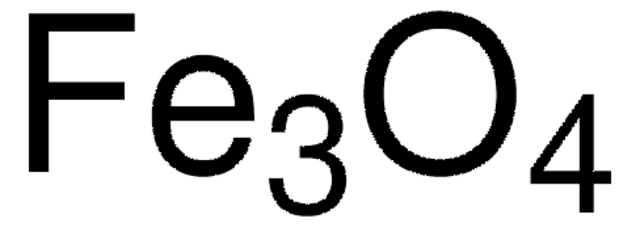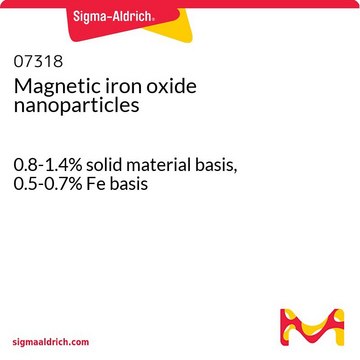700320
Iron oxide(II,III), magnetic nanoparticles solution
5 nm avg. part. size, 5 mg/mL in toluene
Synonym(s):
Magnetic iron oxide nanocrystals, Magnetite, Superparamagnetic iron oxide nanoparticles
About This Item
Recommended Products
form
nanoparticles
solution
Quality Level
concentration
5 mg/mL in toluene
magnetization
≥30 emu/g (at ambient temperature under 4500 Oe)
avg. part. size
5 nm
particle size
5 nm±1 nm (TEM; conforms)
density
0.865 g/mL at 25 °C
SMILES string
O=[Fe].O=[Fe]O[Fe]=O
InChI
1S/3Fe.4O
InChI key
SZVJSHCCFOBDDC-UHFFFAOYSA-N
Looking for similar products? Visit Product Comparison Guide
Related Categories
General description
Signal Word
Danger
Hazard Statements
Precautionary Statements
Hazard Classifications
Aquatic Chronic 3 - Asp. Tox. 1 - Flam. Liq. 2 - Repr. 2 - Skin Irrit. 2 - STOT RE 2 - STOT SE 3
Target Organs
Central nervous system
Storage Class Code
3 - Flammable liquids
WGK
WGK 3
Flash Point(F)
39.9 °F
Flash Point(C)
4.4 °C
Personal Protective Equipment
Regulatory Information
Choose from one of the most recent versions:
Already Own This Product?
Find documentation for the products that you have recently purchased in the Document Library.
Which document(s) contains shelf-life or expiration date information for a given product?
If available for a given product, the recommended re-test date or the expiration date can be found on the Certificate of Analysis.
How do I get lot-specific information or a Certificate of Analysis?
The lot specific COA document can be found by entering the lot number above under the "Documents" section.
How do I find price and availability?
There are several ways to find pricing and availability for our products. Once you log onto our website, you will find the price and availability displayed on the product detail page. You can contact any of our Customer Sales and Service offices to receive a quote. USA customers: 1-800-325-3010 or view local office numbers.
What is the Department of Transportation shipping information for this product?
Transportation information can be found in Section 14 of the product's (M)SDS.To access the shipping information for this material, use the link on the product detail page for the product.
What method is used to determine the size of the particles in Product 700320, Iron oxide, magnetic?
TEM used to check particle size. Light Scattering or similar methods are not utilized.
How is the magnetization of Product 700320, Iron oxide, magnetic, determined?
Per the supplier, the magnetization is determined by using a Magnetic Susceptibility Balance.
What is the purpose of the oleic acid in Product 700320, Iron oxide, magnetic?
Per the manufacturer, the oleic acid allows the iron oxide nanoparticles to be soluble in the solvent (i.e. toluene).
What is the coating thickness of oleic acid on product number 700312, 700320, and 700304, Iron oxide(II,III), magnetic nanoparticles solution?
The suppliers of the magnetic iron oxide nanoparticles in toluene have indicated that the particles are essentially coated with a monolayer of oleic acid. Since the oleic acid is a long chain hydrocarbon there can exist some folding and irregular structure on the surface. The suppliers estimate that one should add 1-2 nm to the particle size due to the presence of the oleic acid coating. From this, 1.5 nm is the closest approximation of coating thickness as provided by our suppliers.
How should a sample of the Iron oxide(II,III), magnetic nanoparticles solution in toluene be prepared for analysis by transmission electron microscopy (TEM)?
The particle size is determined by TEM.If the solution as provided is not diluted, a superlattice of multilayer nanocrystals will form on the grid, appearing to be an aggregate. The solution can be diluted with the same solvent that it was shipped in (toluene). A solution diluted to 0.1-0.5 mg/mL should be concentrated enough to get a nice picture. One drop per grid should be sufficient. (Since the solution is provided at a concentration of 5 mg/mL, this would be a 10- to 50-fold dilution.)After applying the sample to the grid, a drying time of a minimum of 10-15 minutes is recommended.After performing several successful dilutions and getting good results, the analyst will get a feel for the correct dilution just by judging the color and darkness of the diluted sample. If you see lone isolated dots in the TEM, then your sample is too dilute. If you cannot distinguish separate particles, it is too concentrated. Good record keeping will help to zero in on the best dilution factor for the type of picture that you want.
My question is not addressed here, how can I contact Technical Service for assistance?
Ask a Scientist here.
Articles
Graphene is a unique two-dimensional (2D) structure of monolayer carbon atoms packed into a dense honeycomb crystal that has attracted great interest due to its diverse and fascinating properties.
Professor Hui Mao explores the use of superparamagnetic iron oxide nanoparticles (INOPs) that offer an alternate contrast-enhancing mechanism.
Prof. Yadong Yin discusses various synthesis methods of magnetite nanocrystals and their applications in different fields.
Magnetic materials find diverse applications from data storage to renewable energy.
Our team of scientists has experience in all areas of research including Life Science, Material Science, Chemical Synthesis, Chromatography, Analytical and many others.
Contact Technical Service



